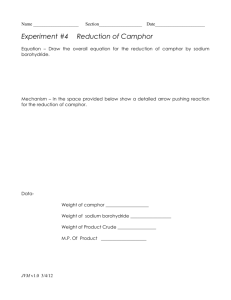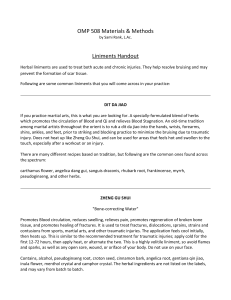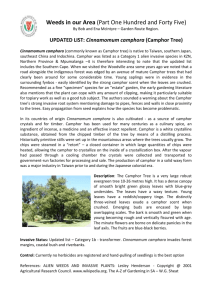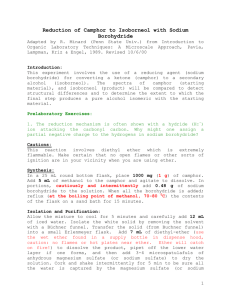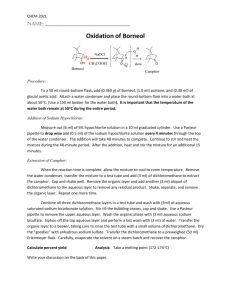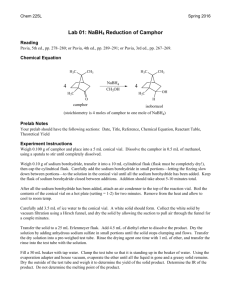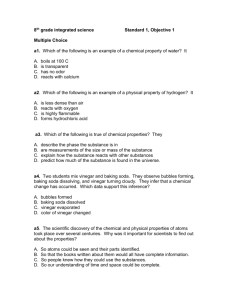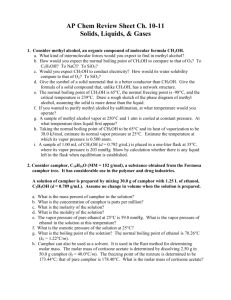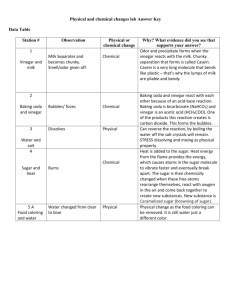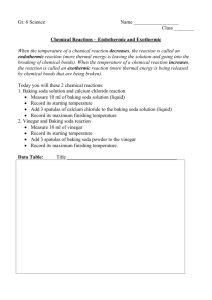Physical & Chemical Changes
advertisement
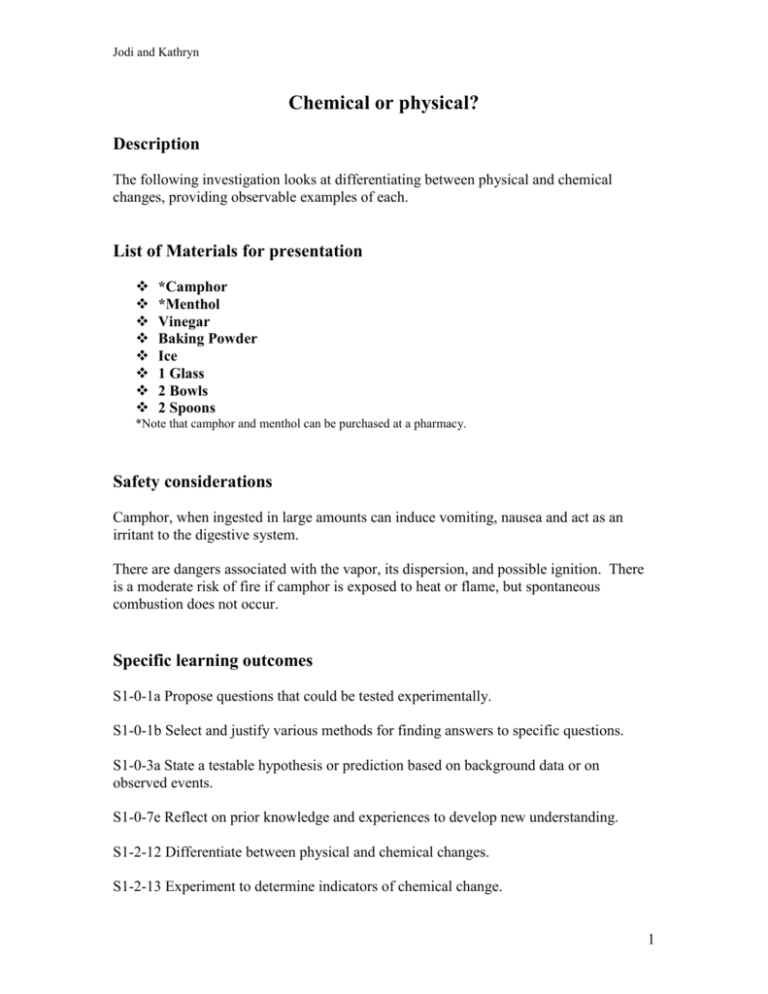
Jodi and Kathryn Chemical or physical? Description The following investigation looks at differentiating between physical and chemical changes, providing observable examples of each. List of Materials for presentation *Camphor *Menthol Vinegar Baking Powder Ice 1 Glass 2 Bowls 2 Spoons *Note that camphor and menthol can be purchased at a pharmacy. Safety considerations Camphor, when ingested in large amounts can induce vomiting, nausea and act as an irritant to the digestive system. There are dangers associated with the vapor, its dispersion, and possible ignition. There is a moderate risk of fire if camphor is exposed to heat or flame, but spontaneous combustion does not occur. Specific learning outcomes S1-0-1a Propose questions that could be tested experimentally. S1-0-1b Select and justify various methods for finding answers to specific questions. S1-0-3a State a testable hypothesis or prediction based on background data or on observed events. S1-0-7e Reflect on prior knowledge and experiences to develop new understanding. S1-2-12 Differentiate between physical and chemical changes. S1-2-13 Experiment to determine indicators of chemical change. 1 Jodi and Kathryn S3C-0-U2 Demonstrate an understanding of chemical concepts. S3C-0-S2 State a testable hypothesis or prediction based on background data or on observed events. S3C-0-A2 Value skepticism, honesty, accuracy, precision, perseverance, and openmindedness as scientific and technological habits of mind. C30S-1-04 Explain the process of melting, solidification, and deposition in terms of the Kinetic Molecular Theory. C30S-1-05 Use the Kinetic Molecular Theory to explain the process of evaporation and condensation. How to present the activity There will be three reactions to observe. Depending on class size, you may break class into groups. Put ice into the glass. Have the class predict what may happen over time if the ice is left in the glass. What will happen? It will melt. What kind of reaction do you think this is? Chemical or Physical? Do not answer this question for them yet. Have students spoon baking soda into bowl. Have the students predict what may happen when vinegar is added, then add an equal part of vinegar. What is happening with the mixture? ie. Sound, new smells, colour, etc. Based on these observations, is this a chemical or physical change? The third reaction is camphor and menthol. Again, have students predict what will happen when these two solids are mixed together. Then, spoon an equal amount of camphor and menthol into a bowl and crush together. Note that this reaction may take a few minutes, as mixing is difficult. Have students note any sound, new smells, colour changes? Was this a physical or chemical change? Students will most likely think that this is a chemical change. Discuss the differences between the physical and chemical reactions that were observed. Explain to the students that physical changes are only a change of state and chemical changes are a change in chemical composition into a new substance. An additional example of chemical change is wood combustion. 2 Jodi and Kathryn Theoretical Background/Explanation In most circumstances, a substance will exhibit the three classical phases of matter under normal conditions. Thus, they will go from solid to liquid to gas or vice versa. Each substance has well defined temperature and pressure conditions where the phases occur, or sometimes ranges where it occurs. These are physical changes. Chemical changes elicit a transformation in the chemical make-up of different substances to form a new substance. Other chemical changes can include the caramelization of sugar or sodium metal and water. Ice, in its frozen state will have water molecules in a regular, stable (or unmoving) pattern. As the “frozen water” or ice begins to heat up, the water molecules (H2O) will begin to move much more rapidly and will no longer be in a regular stable pattern. As the temperature increases, the water molecules become increasingly fluid, or move around in a random pattern. This again, is a physical change. When the vinegar and baking soda is mixed together, the bonds in each of them break apart from each of the atoms and form more stable bonds or have a stronger attraction to other compounds, thus forming a new substance. For the purposes of this assignment, we have used vinegar and baking soda because it was easily accessible. However, if you have access to HCl (hydrochloric acid) and NaHCO3 (sodium bicarbonate) you can have an exercise where the students become an atom of each compound and reform or regroup with other “student atoms” to form the new substances, NaCl (sodium chloride), H2O (water) and CO2 (carbon dioxide). This is a great way to make chemical changes real and tangible. For camphor, however, its natural tendency is to sublimate, or go directly from a solid to a gas at room temperature, albeit rather slowly. When it is mixed with menthol, the new substance adulterates the camphor and the mixture forces it to go through the liquid state. In other words, adding a foreign substance will cause the substance to become impure and change its physical properties, or changes that do not change the composition of the substance. Disequilibrium for the student Students are expecting that two solids, when mixed together, will not form a liquid, as in the camphor-menthol reaction. In general, students learn that phase changes are sequential: from a solid to liquid to gas. However, these steps may not be sequential for all compounds and there are always exceptions to the rules. Students should be aware that scientific anomalies exist. 3 Jodi and Kathryn Students may be confused about mixing two substances together and not forming a chemical reaction. Remind the students the definitions of physical and chemical reactions. References Kotz, J.C., & Treichel, P. (1999) Chemistry and Chemical Reactivity. Saunders College Publishing. Moore, J.W., Stanitski, C.L., & Jurs, P.C. (2002) Chemistry: the Molecular Science. Thomson Learning. 4
